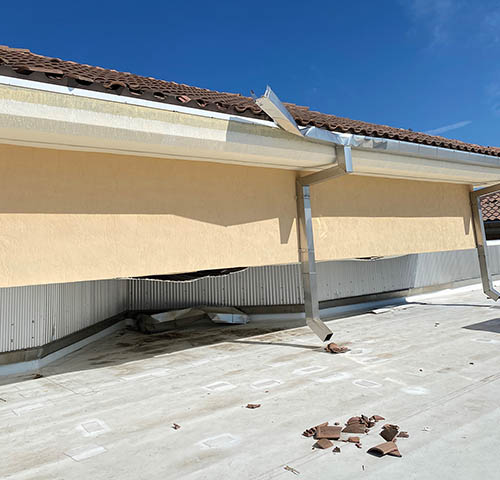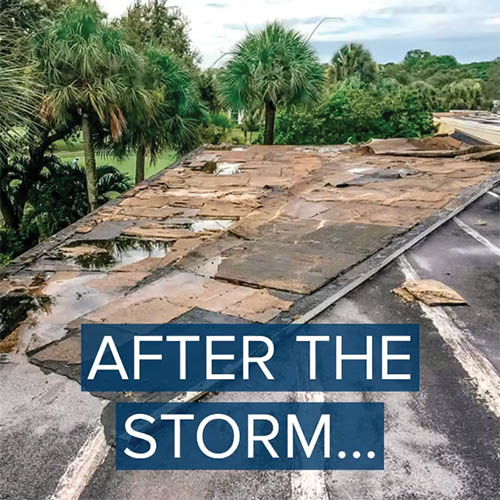— By Bill Pegnato —
Minimizing roof losses during severe weather events — and keeping your facility open.
Retail and restaurant chain locations are expensive to build and have enough operational challenges without being shut down for weeks or months because a hurricane or tropical storm damaged a facility’s roof. But let’s face it: severe storms are happening more frequently these days. According to the U.S. Environmental Protection Agency, 9 of the top 10 years for extreme 1-day precipitation events have occurred since 1996.

Hurricane season started June 1, but fall and winter come after it, so it’s never too late to prepare commercial roofs to weather future storms. Roofing is the second most expensive investment in a building, and it’s crucial to maximize TCO for these assets. Most roofs in good condition can withstand all but the most devastating storms with only minor damage, but the challenge is to know whether or not each roof is in good condition — and to be able to keep it that way.
There are two steps to minimizing roof losses during severe weather: (1) having up-to-date status information, and (2) getting regular inspections with timely repairs.
Roof Intelligence
Typically, the roof is largely a forgotten asset that only gains mindshare when there’s a leak. Few if any commercial facility managers ever set foot on their roofs. Given the nature of chain expansion, though, there’s bound to be a wide variation in roof conditions at various sites.
But how do managers know the status of each roof? They need to know how old the roof is, what condition it’s in, when it was last inspected, and whether there are any potential trouble spots. Even with the best paper or electronic report filing system, however, it’s a time-consuming task to locate any roof’s last inspection report, or to look up the invoice that shows when a roof was last replaced. The result is that most of the time, facility managers are not aware of roofing problems until there’s a leak.
Inspections and Repairs
Roof inspections reveal trouble spots and overall condition — hopefully before leaks occur. A qualified inspector will walk the roof and spend some time checking for broken or dislodged tiles, damaged gutters or downspouts, soffit or wall cracks, separating roof material seams, cracks in roof penetration seals, unsecured grease vents and other issues that can quickly turn into damaging problems during severe weather.

Of course, the accuracy of an inspection report depends on who’s looking. When a facility manager oversees a far-flung portfolio of geographically distributed locations, it’s usually impossible to rely on just one favored commercial roofing contractor for timely and accurate inspections. This is especially true if, like many restaurant chains, the portfolio is constantly expanding into new areas. If a roof has never been inspected or repaired, managers may not know who to call. Moreover, if the inspection reveals roof areas that need attention, the challenge is to get a qualified crew to make repairs as quickly as possible, preferably before the next storm hits.
Just as auto body shops become swamped right after rainstorms, roofers are swamped after storms. It can take weeks just to get a location inspected, let alone repaired — weeks when the facility may have to close. And under pressure to get a site reopened after a major leak, facility managers may turn to the most available roofing contractor, who may well not be the most qualified.
What to do? One approach is to get referrals from known contractors who have given good service in the past. More recently, however, we are seeing new online roofing information platforms that can connect managers with pre-vetted local contractors. Think of these as Uber-like platforms for roofing status information and access to qualified contractors — just as Uber doesn’t own any cars or directly employ any drivers, these platforms are offered by companies that leverage their roofing industry expertise to provide immediate, online access to qualified services.
As neutral third-party sources, these platforms aren’t influenced by a contractor’s size or prominence, but rather by the contractor’s ability to deliver great services to the right location in a timely manner. After all, if the platform doesn’t deliver, it won’t be around very long.
The roofing business has been slower than many to adopt online platforms that speed workflows, deliver immediate access to information, increase efficiency and reduce TCO. Online roofing information and service platforms deliver on these benefits.
— Bill Pegnato is CEO of Pegnato Roof Intelligence Network (PRIN), a roofing asset management platform that reduces TCO by providing immediate access to comprehensive roof condition information, qualified roofing services, and job status. Pegnato is a 40-year veteran of the roofing industry, and PRIN is currently used to manage more than $2 billion worth of retail and restaurant facility assets.

